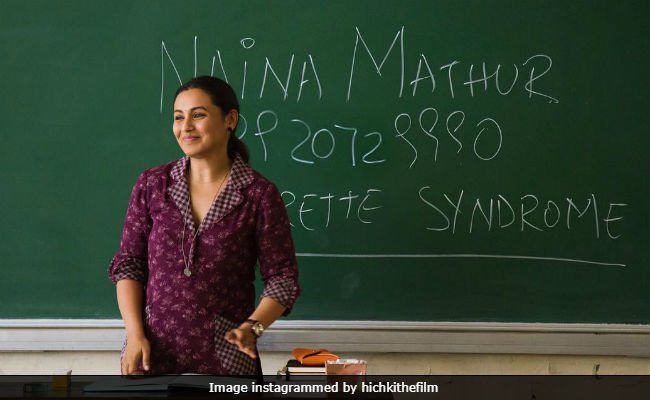Directed by Sidharth P Malhotra and produced by Maneesh Sharma and Aditya Chopra under the banner of Yash Raj Films, Hichki deals with an offbeat subject that is rarely depicted and discussed in popular cinema.
Through protagonist Naina Mathur (Rani Mukerji), who has Tourette Syndrome, Hichki intelligently attempts to break stereotypes and debunks myths related to those living on the fringes of society. How many of us have actually heard of Tourette Syndrome before the release of this movie?
I think not even a fraction of our population would have known about this neurological and motor disorder. The person who has this disorder may involuntarily make sudden, brief, intermittent movements or sounds that might significantly interfere with communication, daily functioning and quality of life.
By linking the realities of the economic weaker section of the society on one hand and a person confronting a disorder on the other, Hichki brings out the exclusionary tendencies of our society.
Naina Mathur suffers exclusion even while studying in an inclusive school. In the same way, a group of students belonging to an economically weaker section of society are seen with contempt and completely neglected in the same educational set up. The sarcastic statement of Principal of St. Noker’s High School clearly indicates his disapproval of inclusive structures when he says, “Thanks to Right to Education” they have to accommodate students from nearby slums.
How many of us have actually heard of Tourette Syndrome before the release of this movie?
Fourteen students are lumped together in Class 9 F with a teacher with Tourette Syndrome, who after several interviews and numerous rejections, lands her dream job as a full-time teacher. The class in the elite school that is assigned to her comprises of disobedient, arrogant and headstrong students. Those who are unaccepted, unacknowledged and abhorred are bunched together.
Hichki beautifully depicts how persons with disorders and disabilities are singled out. Whether it is her own father, her classmates, her teachers in school, her employers, her colleagues or society, Naina Mathur is seen as a person unfit to mingle in society. Though her hichkis (hiccups) or the involuntary sounds due to her syndrome could be briefly suppressible, they are shown to be triggered by environmental stimuli. She has to put up with stares and sniggers.
She is mocked and bullied even by her students. No one is sure of her capabilities but she herself is shown to be damn sure of her potential when she tells her interviewers, “Meri speech me Tourettes hai, meri intellect me nahi” (My speech is affected by Tourettes, not my intellect).
Also Read: So How Has Indian Cinema Portrayed Women With Disabilities?
This is exactly what we, the people with disabilities, face every day. Society has minimal expectations of us and our abilities are always put under scanners. Even her father is apprehensive about her abilities and frequently tries to snatch away her right to decide and choose, whether it is her career or her favourite dish in the restaurant!
He is embarrassed and ashamed of her disorder and tries to hide it from people. He gets irritated by her speech impairment and frustratingly tells her to “speak normally”. Although there’s no cure for Tourette syndrome, her educated yet ignorant father, like hundreds of disabled children’s parents, is seen grieving at his failure to get her disorder “fixed”.
Naina portrays an individual who has completely accepted her limitations and verbally hits back saying, “This is ‘normal’ for me as my syndrome is now a part of me and I don’t need to be ‘fixed’ ”. She does not even mind making fun of her tics. While talking to someone on the phone, she is seen telling someone that it was the sound of her dog barking!
She makes her weakness her strength and stands alone against the whole world where she has been singled out for making odd noises, grunting in class and just being fidgety at all times. Naina overcomes all challenges to help her students realise their true potential. She not only stands for her own rights but also fights for the slum children and their rights. She openly talks about equal opportunities.
The stigma attached to the economically disadvantaged as well those with disorders and disabilities is openly seen when Mr Wadia, another science teacher says, “They did not belong here, they never did, they never will”. She retorts back saying, “They will sir, shayad humne koshish hi nahi ki that they do belong” (Perhaps no one has even tried to make them feel that they also ‘belong’). Here comes the full meaning of inclusion when we all feel and make others feel that they do “belong”. Every one of us is part of the same society irrespective of physical abilities or economic status.
Hichki here also turns out to mean our own reluctance to bring about changes.
Hichki also gives a strong message that before the world accepts and embraces diversity, we need to acknowledge and accept our reality in a positive and healthy way. If we internalize discrimination, the chasm between ‘they’ and ‘us’ will never get filled.
In the end, this change is depicted when 9 F is seen participating in the National Science Fair with other students and Naina is heard stating that, “equations in books and syllabi remain the same. Equations among the students changed a little and some new equations were formed. Like me, others also befriended their Tourettes. Sometimes I think what is Tourettes? Is it the presence of strange sounds and hiccups or just our hesitation or unwillingness? Because it is a matter of our perception that determines the difference between why and why not?“
Hichki here also means our own reluctance to bring about changes and when we hear, “Har hichki sunayi nahi deti” (every hiccup is not heard): the message is loud and clear. We all have our shortcomings, unknown fears and apprehension. We need to change mindsets and clear the fog of doubts. Sometimes mental hurdles become more problematic than the physical limitations which we can cross when we are accepted unconditionally, not only by our own self but also by everyone around us.
Even the title song attempts to address the rampant discrimination in society towards a preference for fair skin, women with disabilities, transgender and other marginalized groups. It is symbolic of the mental blocks which we all have towards those who are unable to ‘fit into’ standards of normalcy created by age old perceptions.
Also Read: ‘Inspiration Porn’ And Deconstructing The ‘Disabled People Are So Inspiring’ Stereotype
Featured Image Credit: NDTV
About the author(s)
A writer, a counsellor, a teacher, a social worker, a motivational speaker and an activist, Abha Khetarpal, is a National Awardee and one of the 100 Women Achievers in India. She has surfaced in Women Of Pure Wonder, a Coffee Table Book by Vodafone and also honoured with Woman of Substance Award. She works for persons with disabilities. Being a woman with disability her major focus remains on women with disabilities for whom she has authored manuals like ‘Keeping You Abreast; A handbook on breast cancer self examination’ and ‘Going with the Flow; Handbook on Menstrual Management & Hygiene’.




